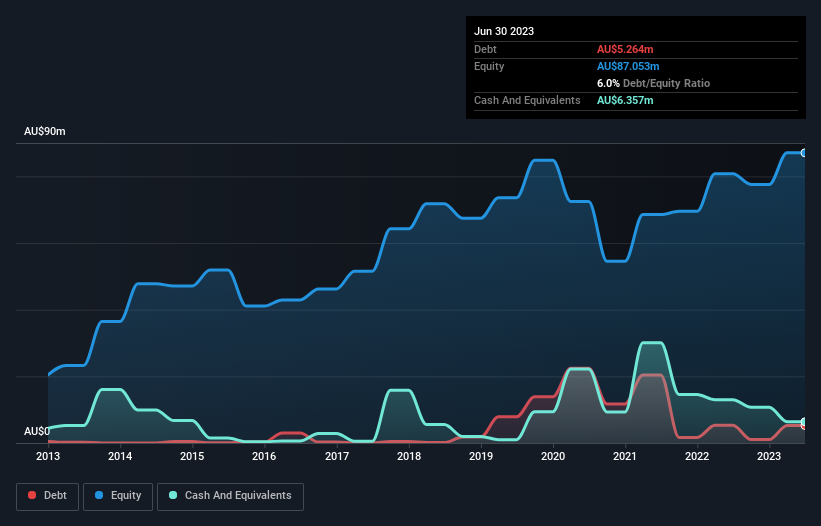David Iben put it well when he said, 'Volatility is not a risk we care about. What we care about is avoiding the permanent loss of capital.' So it might be obvious that you need to consider debt, when you think about how risky any given stock is, because too much debt can sink a company. As with many other companies Clean Seas Seafood Limited (ASX:CSS) makes use of debt. But is this debt a concern to shareholders?
What Risk Does Debt Bring?
Debt is a tool to help businesses grow, but if a business is incapable of paying off its lenders, then it exists at their mercy. Ultimately, if the company can't fulfill its legal obligations to repay debt, shareholders could walk away with nothing. While that is not too common, we often do see indebted companies permanently diluting shareholders because lenders force them to raise capital at a distressed price. Of course, plenty of companies use debt to fund growth, without any negative consequences. The first thing to do when considering how much debt a business uses is to look at its cash and debt together.
Check out our latest analysis for Clean Seas Seafood
How Much Debt Does Clean Seas Seafood Carry?
As you can see below, Clean Seas Seafood had AU$5.26m of debt, at June 2023, which is about the same as the year before. You can click the chart for greater detail. However, its balance sheet shows it holds AU$6.36m in cash, so it actually has AU$1.09m net cash.

A Look At Clean Seas Seafood's Liabilities
The latest balance sheet data shows that Clean Seas Seafood had liabilities of AU$16.8m due within a year, and liabilities of AU$5.35m falling due after that. Offsetting this, it had AU$6.36m in cash and AU$5.22m in receivables that were due within 12 months. So its liabilities total AU$10.5m more than the combination of its cash and short-term receivables.
Of course, Clean Seas Seafood has a market capitalization of AU$60.4m, so these liabilities are probably manageable. However, we do think it is worth keeping an eye on its balance sheet strength, as it may change over time. While it does have liabilities worth noting, Clean Seas Seafood also has more cash than debt, so we're pretty confident it can manage its debt safely.
In fact Clean Seas Seafood's saving grace is its low debt levels, because its EBIT has tanked 31% in the last twelve months. When it comes to paying off debt, falling earnings are no more useful than sugary sodas are for your health. There's no doubt that we learn most about debt from the balance sheet. But ultimately the future profitability of the business will decide if Clean Seas Seafood can strengthen its balance sheet over time. So if you're focused on the future you can check out this free report showing analyst profit forecasts.
Finally, a business needs free cash flow to pay off debt; accounting profits just don't cut it. While Clean Seas Seafood has net cash on its balance sheet, it's still worth taking a look at its ability to convert earnings before interest and tax (EBIT) to free cash flow, to help us understand how quickly it is building (or eroding) that cash balance. During the last two years, Clean Seas Seafood burned a lot of cash. While investors are no doubt expecting a reversal of that situation in due course, it clearly does mean its use of debt is more risky.
Summing Up
Although Clean Seas Seafood's balance sheet isn't particularly strong, due to the total liabilities, it is clearly positive to see that it has net cash of AU$1.09m. So although we see some areas for improvement, we're not too worried about Clean Seas Seafood's balance sheet. The balance sheet is clearly the area to focus on when you are analysing debt. However, not all investment risk resides within the balance sheet - far from it. For example Clean Seas Seafood has 3 warning signs (and 1 which can't be ignored) we think you should know about.
If, after all that, you're more interested in a fast growing company with a rock-solid balance sheet, then check out our list of net cash growth stocks without delay.
New: AI Stock Screener & Alerts
Our new AI Stock Screener scans the market every day to uncover opportunities.
• Dividend Powerhouses (3%+ Yield)
• Undervalued Small Caps with Insider Buying
• High growth Tech and AI Companies
Or build your own from over 50 metrics.
Have feedback on this article? Concerned about the content? Get in touch with us directly. Alternatively, email editorial-team (at) simplywallst.com.
This article by Simply Wall St is general in nature. We provide commentary based on historical data and analyst forecasts only using an unbiased methodology and our articles are not intended to be financial advice. It does not constitute a recommendation to buy or sell any stock, and does not take account of your objectives, or your financial situation. We aim to bring you long-term focused analysis driven by fundamental data. Note that our analysis may not factor in the latest price-sensitive company announcements or qualitative material. Simply Wall St has no position in any stocks mentioned.
About ASX:CSS
Clean Seas Seafood
Operates in the aquaculture industry in Australia, Europe, North America, Asia, and internationally.
Mediocre balance sheet low.
Similar Companies
Market Insights
Community Narratives




